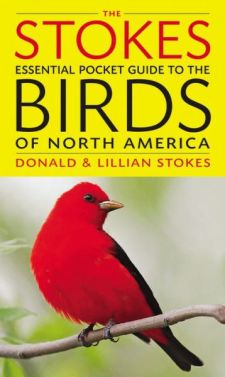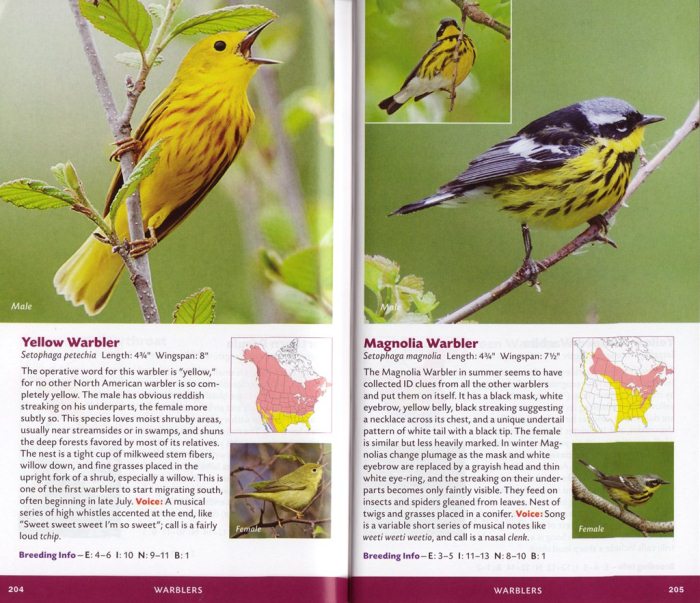Reviewed by Grant McCreary on March 17th, 2015.
In 2010, the husband-and-wife duo of Donald and Lillian Stokes produced the finest, most comprehensive photographic field guide to North American birds, The Stokes Field Guide to the Birds of North America. But as nice as that guide is, it’s the size of a brick – and it feels like it weighs as much as one, too. Its comprehensiveness may also be intimidating for new and prospective birders. Now, four-some years later, the Stokeses have come out with a new book on the opposite end of these spectrums – The Stokes Essential Pocket Guide to the Birds of North America.
This “pocket guide” is a small, attractive guide to 255 of the most commonly observed birds in the United States (Lower 48) and Canada. Although the back cover claims this book is for birders “at any level of experience”, it is most appropriate for those just starting out. Everything about this guide, from the introduction to the text to the large, spectacular photos, is designed to help new birders start identifying birds.
Each bird (except for the meadowlarks, which share an account) has a one-page account that includes photographs, text, and range map. The accounts are organized in an interesting manner, separated into “water birds” and “land birds”. This is similar to the scheme proposed by Steve Howell, Richard Crossley, and others, which has been implemented in their respective guides (pdf of the proposal). But the similarity ends at this first division, as the Stokeses stick with a (mostly) taxonomic ordering within these two main sections, as opposed to the further changes proposed by Howell, et al. This is a step in the right direction, but I think beginning birders would have benefited by taking it all the way and juxtaposing similar groups of birds, such as vireos and warblers, swifts and swallows. As it is, it should be fairly easy to find what you’re looking for, especially with the color-coded page bottoms, indexed on the first page, and quick-find alphabetical index on the front-inside cover flap.
This may be a small book, but it packs a huge punch visually thanks to the fantastic pictures, most taken by Lillian Stokes. A single, large, striking photo occupies the top half of each account, although in some cases there are instead two equal-sized photos, or a smaller shot inset into the big one. Additionally, each account has a smaller picture below the range map, used to depict the female, the bird in flight, or some other interesting pose. Some of the raptors have composite images, with multiple birds “photoshopped” together, as pioneered by Richard Crossley in his ID guide series. Altogether, the Stokes Pocket Guide includes a surprising number of photographs.
If a bird has different plumages based on sex, age, season, or region, the authors have tried to illustrate each. Clearly, a pocket guide such as this can’t show everything, but I am pleasantly surprised by how much variation is included. However, there are some notable gaps. The secondary photos for Northern Bobwhite and Red-headed Woodpecker are very similar to the primary picture, instead of showing the different female and immature, respectively. Similarly, the Fox Sparrow page shows two “Easterns” (Red Fox Sparrows), instead of also including the other types.
The text includes “detailed identification information…interesting behavior, food preferences, habitat, nest materials and placement, and vocalizations.” It is completely new for this guide, instead of being adapted from previous incarnations of the Stokes guide. That way, the authors can focus on the information that beginners really need and want. I’m glad to see an emphasis on nesting habits in the text, which is accompanied by further breeding information at the end of the account that gives the numbers of eggs in a brood, days of incubation, days of nesting, and broods in a season. Backyard birdwatchers will also appreciate icons that indicate if the species is attracted to feeders or birdhouses.
Each species has a range map that uses four colors to indicate permanent, summer, winter, and migration ranges. Dotted lines indicate the extent of rare occurrences. The maps are relatively large and are “zoomed in” as appropriate for less extensive ranges, making it easy to see the details.
The introduction is fairly short, but covers some topics that will be of great interest to beginning birders, such as how to use this field guide, buying and using binoculars, and tips on identifying, attracting, and helping birds.
One of the most important things with pocket guides such as this is species selection. I can’t imagine the dilemma of taking a list of 900+ birds and whittling it down to just 250. Sure, some are easy to eliminate, like vagrants and remote breeders. But there’s still not enough room to include all the birds you’d want! That said, the Stokeses have done a very good job in their selections. I didn’t notice any glaring omissions, although I’m sure that some users will wonder why X was included, but not Y. But that’s par for the course.
Recommendation
The Stokes Essential Pocket Guide to the Birds of North America is informative, extremely attractive, and easily portable, making it an excellent field guide for a beginning birder or anyone who appreciates birds or is curious about them, but doesn’t consider themselves a full-fledged birder.
Disclosure: I get a small commission for purchases made through links in this post.
Buy from NHBS
(based in the U.K.)
Disclosure: The item reviewed here was a complementary review copy provided by the authors. But the opinion expressed here is my own, it has not been influenced in any way.







Comment